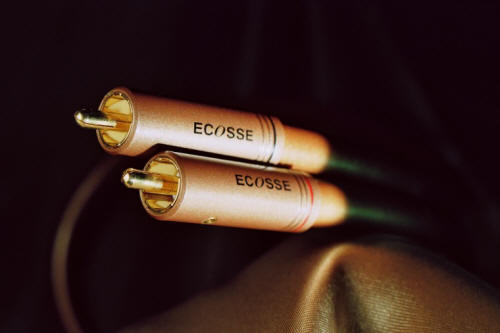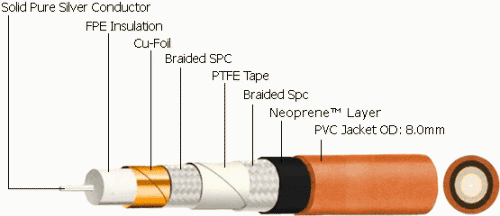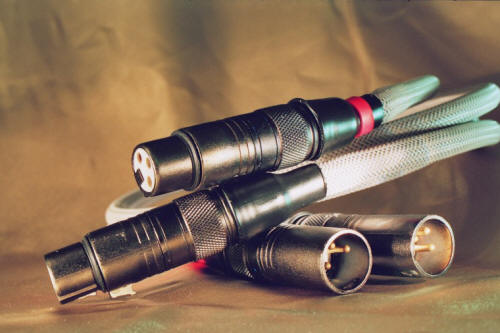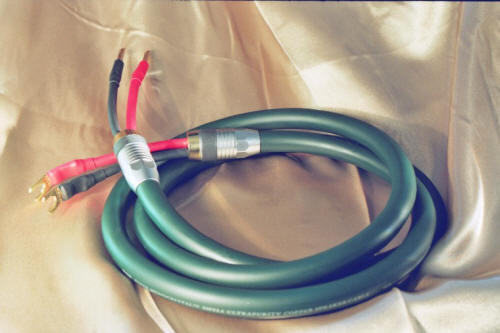
You are reading the older HTML site
Positive Feedback
ISSUE
29
ecosse cables
Ecosse "Least Lossy" Cables: Elegance in Wires - the Myth/Pro interconnect and SMS2.4 loudspeaker cables
as reviewed by Max Dudious

Introduction
On the shores of the Chesapeake, my recollections of Februaries past contain freezes so severe the railroads ran tracks across the ice to the Eastern Shore. For months it was cold enough, the sea-salt-thickened-ice thick-enough, to keep dappled-dawn-drawn freight-trains from plunging into the briny deep. I've had ocular proof, photos of these tracks and trains on display, at our central Library, named for 19th century Baltimore philanthropist Enoch Pratt, the father of lending library systems. Since this recent bout of global warming began, the ice hasn't gotten thick enough to run trains across, and, it no longer is an advantage, as big trailer-trucks crossing the Chesapeake Bay Bridge would have made rail traffic redundant. But this winter might be a harbinger of a new cycle of, er ...global chilling. The weather outside is frightful, snowing as it has been all day. That's probably what's got me off on this tear.
What has this to do with Ecosse interconnect and loudspeaker cables? Nothing, but it allows me to use the word "redundant." Redundant, or superfluous prolixity, is the restating of something in a manner not offering any additional information. I could say, "Ecosse cables are among the best I've heard." And that would do it. But it is in the telling of how, and why Ecosse are so good that makes Ecosse cables fascinating and gives anyone interested in them enough information to consider actually purchasing them. I will also say, "As audiophile grade cables go, they are not cheap." But for questers, for those seeking the holy grail of reproduced sound so lifelike it can fool the ear (trompe-l'oreille?) into hearing live musicians in the listening room, for those knights errant they seem a bargain. I'll try not to be redundant if you agree to read on. That is, I won't be superfluously prolix if you keep slogging along. That is, I'll try not to repeat myself needlessly if you'll keep trying to make speed on my screed. "Claghorn's the name, Senator Claghorn. And I never repeat myself."
For example, the Scottish Ecosse products are among the most decorated I know of, having won numerous awards from the audio press in the U.K. and Europe. That's an intriguing fact. They earn the highest praise from reviewer John Acton (with whom I agree), writing in that prestigious journal Positive Feedback Online. [For his complete review see PFO Issue 25, May/June 2006, at https://positive-feedback.com/Issue25/ecosse.htm.) One can't help but wonder if our John Acton is a descendent of England's Lord Acton (who, in a much quoted letter of 1887, famously opined, "Power tends to corrupt, and absolute power corrupts absolutely."), if he is someone whose parents named him in Acton's honor, or if he himself has taken as an homâge this nom de plume.] In any event, I feel it is incumbent upon me to get my two cents in.
A Little Refresher
To make a superior interconnect or loudspeaker cable the designers have to strike the just right mix of metallurgy, physical chemistry, geometry, and vibration control. There are numerous mixtures that lead to excellent sound as witnessed by the use of rare metals (such as Palladium), exotic insulation (Teflon© and similar low-Q substances), various physical types (ribbon, rope lay, or various clusters), and vibration absorbing insulation and jackets (neoprene, PVC and others); and there are various recipes for brighter, crisper; or warmer, edges rounded off—cables. Some cables seem to have a bass-boost or cut, while others seem to have a high frequency boost or cut. Such cables are useful, as they can compensate for irritating anomalies in systems, or in listening rooms. The Ecosse Myth/Pro interconnects and the Ecosse SMS2.4 loudspeaker cables are among the most "neutral" I've heard. The designers seem to have made neutrality a design goal, and they have been successful in coming up with designs, in their words, that 'least subtract the vital musical information to let the music flow through!' Put simply, they are the least lossy cables I can remember hearing.
Briefly, if the physical chemists are right, electric current in a wire follows the model of water in a pipe, to some extent. At least, when you turn the valve (vacuum tube) more open, more water (current) can pass through the pipe (wire). Well, since this model doesn't work exactly that way, we can say electric current flowing through a wire is analogous to water in a pipe. Actually, there is a more informative desk ornament many of us have seen, where six stainless steel ball bearings are hung by individual strings from a triangulated wooden contraption such that they are in alignment. When you take the end ball (#1) and hang it in space, and then suddenly release it, it swings down in an arc and smacks into its neighbor (#2). The energy is transferred through #2, #3, #4, #5, and #6 pops out of the line at the far end. It then reaches the apogee of its arc and swings back down to smack into #5, and #1 pops out at the near end. I hope you now have a mental picture of this in your mind. If the model is well aligned, #2, #3, #4, and #5 don't seem to move at all. And this system can "run" for some time before the energy is dissipated.
Electrons in a wire operate in a similar way: an energized electron jumps into a molecule of metal, which is in a crystalline form, and this pushes an electron out of its nearside neighbor crystal which then jumps into its far-side neighbor crystal. This 2nd crystal forces an electron to jump from its place into a 3rd crystal on its far-side, and so on down the length of the wire, where the last electron jumps into the loudspeaker, we'll say. In the best designed wires, this might happen at a pretty high speed, say, 75 or 80% of the speed of light has been claimed. Differing metals have different molecular structures, and their physical properties suggest greater likelihood of give and take speed. Furthermore, by fabricating the wires at various temperatures, designers can affect the speed of electron transfer. Slowly freezing the wires to very low temperatures (in liquid nitrogen), then slowly thawing the wires to room temperature, seems to improve the performance of wires by getting the crystals to rest in their most-dense alignment. By controlling (well, somewhat) all these collisions, you can get a better performing wire for audio purposes.
A Little More Refreshing
Another consideration is solid-core vs. finely stranded wire. To achieve good audio performance, all of the notes of a chord ought to depart, say, an amplifier at the same time and arrive, let's say, at the loudspeakers at the same time. But we know that some frequencies like to run down the surface of some finer wires (skin effect) and get to the end before other frequencies that have to go through the center core of even the finest filaments where they are subjected to a greater number of collisions. Some designers take advantage and control for skin effect by having various diameter filaments in one interconnect or speaker cable. Others prefer to use thin copper foil as a conductor because it has a greater percentage of its crystals on the surface. Still other designers find it effective to use more than one metal. Knowing the propagation velocity of various materials, and various diameters of various filaments or foils allows the designer to minimize variations in arrival times at the end of the cable. The result is less "time-smearing" of arrivals, and an improved illusion of "live musicians in the room."

A Little Reminiscing
Similarly, there are materials used in insulation that are chosen because they have a low "Q factor," which means they store relatively few electrons in their material make up as signal passes through. As some electrons are so highly energized they jump off the metal and embed themselves in the insulation, momentarily, the ability to absorb and release electrons quickly is another design concern when choosing insulation. Some materials (Teflon® and polyethylene) have the ability to absorb and release electrons nearly all at once. That means there is no staggered release in real time.
This is audible.
Twenty-five years ago I designed a rather simple crossover network for a pair of "monitor" sized loudspeakers, the crossover being of the simple first-order type. It had one capacitor in the circuit, I think of five or six micro-farad value. I made one with a Mylar™ cap, and the other with a Polypropylene™ cap. I managed over some weeks to test if any of the members of my listening panel could hear any difference. I played a mono recording, and switched from left to right. Everyone immediately heard the difference. Some were amazed at the improvement just one clean capacitor could make. These days, all the better companies brag about what clean capacitors they use. But it wasn't always so.
The point being, modern cable designers now use Foamed Polyethylene and sheathed Teflon as insulation as a matter of course. Such materials have become the norm for the better cables.
With A Little Help From My Friends At Ecosse
Ecosse proudly (and justly so) displays a cut-away diagram of their US2 Monocrystal™ Silver Myth/Pro Cable at their website. Here is their picture, and you'll note that the cable is made of 8 separate layers. In the center is the signal conductor made of a "solid core conductor 0.33mm sq of 6N purity silver (99.9999%), perfectly circular in cross-section. There are no less than 3 screens to fully protect signal from the deleterious effects of EMI, ESI, and RFI induced distortions." Here the centre core is positive phase, the inner screen negative, and the outer screen becomes 'earth.'

Blowing Their Own Horn
"The [silver] signal conductor has a dielectric of ultra low loss Foamed Polyethylene. The return conductor and inner screen comprise of 100% pure copper-foil [layer] and a close-lapped braid [layer] of silver-plated Ultra-Hi Purity-OFC™ [oxygen-free copper]. This is [all] sheathed in a PTFE (Teflon) separator. The outer screen is a close-lapped braid of silver-plated Ultra-Hi Purity-OFC™ and is grounded at source end only." [Making the outer screen an antenna drawing all the signals floating around and routing them to earth, or chassis ground.]
"The clever bit is the layer of Vibrakill™ Neoprene™ sandwiched between the outer screen and the soft PVC jacket, virtually eliminating the effects of microphony and contributing greatly to the preservation of the accuracy and integrity of the signal.
"The plugs we use to terminate this cable are the latest, ultimate development of Ecosse's MACH2 RCA. Uniquely, their centre pins and conjugate bracket shields (designed to form a 'Faraday Cage' – a device to maximise RF screening) are both deep silver-plated Monocrystal™ Copper."
In Praise of Cable Technology
I haven't seen the engineering data on these cables, but it seems likely that the propagation velocity of the solid core silver conductor, and the copper-foil overlaid with silver plated copper braid return, are designed to have the right complementary values. Every inch of this cable has been well conceived and beautifully executed. The conductor and return, the interior insulation, the screens, the vibration control, and the outer jacket, have all been designed as one. The fit and finish is at the highest level. Although this cable sounds a tad less loud than some of my best reference cables at the same setting, it is the most coherent. I'd guess the designers were willing to concede a dB or so to get the performance response characteristics just right.
So how does it sound, this wonder of metallurgy, physical chemistry, cable geometry, and vibration control? It doesn't sound at all. I mean it has no "sonic personality" and that's the highest praise I can give. It enjoys a pretty flat frequency response. It enjoys a lack of time-smearing. I have the Myth-Pro between my Marantz 8260 CD player and my much improved JC-2 Mark Levinson preamp, and I can report they never sounded better if the goal is to create the best facsimile of live musicians in the room. The attack/sustain/decay ratios are just so spot-on that everyone in a string quartet seems as though he/she is seated in a horseshoe array, and the sounds originate and develop from very well defined points in space. Each instrument sounds as it should and it knows its place, particularly on small chamber jazz groups, like the Tierney Sutton Band album (Telarc SACD-63650).

I also have a pair of Ecosse SMS2.4 loudspeaker cables between my Marantz 8Bs (bridged to mono, and playing as triodes), and my Lowthers (in quasi Richard Dicks enclosures). I bi-amp into my 18" Hartley/Klipsch horns using a Shadow active crossover, and an ADCOM 555 amplifier below 100Hz. The sound is quite good. We all know how the midrange can make or break a system, because that's where 90% of the music is. These cables show to best advantage on some classical music, like David Chesky's Urban Concertos album (Chesky SACD 326). The Ecosse breathtaking SMS2.4 are the latest iteration of a series of top-of-the-line speaker cables, replacing the superb SMS2.3. I use these adjectives advisedly, because that's how the immodest manufacturers describe their cables. I happen to agree, though I haven't heard the .3's; but the .4's take my breath away. Again, I'll quote from their website.
Blowing Their Own Horn, Again
"Ecosse loudSpeaker Cables consist of either woven multi-stranded or 'solidcore' conductors, which are insulated then twisted, (twisting the conductors greatly reduces capacitance and inductance) in a precision helix, laid in a substantial bed of cotton yarn, bound with paper and surrounded in a soft PVC sheath. Conductor material may be Super-Monocrystal™, Monocrystal, Ultrafine, or UHP-OFC [Ultra High Purity- Oxygen Free Copper] ...Very simply, with each upgrade, 'noise' is progressively reduced which helps the overall performance of your system and increases your listening/watching enjoyment."

Similar Idea, More Current
Ecosse also claims to have made a refinement of the Ohno Constant Casting technique, whereby temperature gradients are more strictly controlled, as is their processing environment. It seems some other cable manufacturers have struck out on their own, and a handful of them have developed their own recipes for casting and insulating their own wires. I think this is very healthy development in an open market industry. And, each of the manufacturers is seeking the Grail in his own way.
The Ecosse formula has generated a speaker cable that is very neutral and that keeps everything audible. Where other cables thicken the sound of a massed orchestra and choir at full cry, the Ecosse SMS2.4 keeps from taking on the quality of sonic congestion. These cables retain each of the orchestral voices in its proper size and place, as they manage to retain great clarity no matter how complex or loud the music gets. This in itself is not new. There are many speaker cables that can now do this. What separates the Ecosse SMS2.4 is they do not enter any coloration of their own as the system rises to full cry, and they continue to maintain great clarity of instrumental size and place. Many speaker cables develop colorations as the loudness of the music increases. Some become shrill, I hypothesize, from microphonics within the cables themselves. The Ecosse SMS2.4 develops hardly any colorations no matter how loudly it is played. It is the closest I've heard to "absolutely neutral." I think this is the reputation that they have come to enjoy in Europe. I'm glad to report that I agree, this time, with other reviewers. (If you think that reviewers often agree with each other, or that we follow each other around to quote each other's work incestuously—think again.)

Do You Need These?
Some systems have too full (but not woolly or indistinct) bass that makes orchestral music feel like it is emanating from a funeral parlor; others, too irritatingly strident trebles that make us cringe as does chalk squealing on a blackboard; while still others may have a mid-range where the bite of the brass nearly yanks our ear off. Well, there is none of that with the Ecosse SMS2.4s. The balance of the frequencies seems meticulously worked out. We've each heard systems where the left and right collapse to the center – or where the instruments at the rear of an orchestra move up—as the volume goes up. With certain systems we might be forced to trade off dynamic range for increased spatial cues and play the music less loudly to retain the soundstage information. Well, there is none of that either. In my system, especially with the Lowthers voiced as I have them, I get relatively flat response, where the soundstage remains stable with increased loudness, and the system also retrieves details "down in the mix." With the Ecosse Myth/Pro interconnects and the SMS2.4 speaker cables, I can play my big rig a tad or two tads louder before it starts to complain. A small thing in itself, but revealing of how good these products are.
As an exercise, I took various interconnects and played them in turn between my Sony XA3ES red book CD player and a headphone amp that's hanging around waiting to be reviewed, the Single Power Supra, a big, beautiful, bitchin' 'phones amp. I didn't want to do an exhaustive study, because then you ought to get into great numbers of iterations, and double blind methodology, with different age and sex test subjects. But I did compare about six of the usual suspects to the Ecosse interconnects, and the Ecosse acquitted itself very well when compared to some of my other favorites (Harmonic Technology, Goertz Alpha Core, Monster Retro, Home Grown, Canare, and Grado interconnect cables, each of which has certain virtues). They were more neutral, more natural. The differences were subtle but real, the kind of things that jump out at you through Grado GS-1000 headphones, but which might get lost in a free-standing rig, what with differences in speakers, room nodes, reflections, and cancellations.
If You Must, You Must
I feel pretty certain that these two sets of cables, the Ecosse Myth/Pro interconnect cables, and the Ecosse SMS2.4 loudspeaker cables are among the best at their price points, and are a striking example of applied theory in cable technology. If you are among those who have too much highs, or lows, and you don't know how to get rid of them—you needn't build a dedicated room onto your home, or junk your big rig and start over again from scratch. You might save yourself from dropping too much scratch by turning on to these neutral cables. They are excellent, and worth the effort of tracking them down. If you can't find a dealer, you might be able to deal directly with Ecosse, where some knowledgeable Scot will be waiting to talk to you in cyberspace.
And when you place your order wi' the wee laddie, make sure you tell 'em you drink wi' Max. You might expect any sort of response, because, as everyone knows, Scotland values thrift, and its own eccentrics.
Ciao, Bambini.
Max Dudious
SMS2.4 loudspeaker cables
Retail: $1200 for
a 3-meter pr.
Myth/Pro interconnects
Retail: $949 per 0.8-meter pr.
Ecosse Cables
web address:
www.ecossecables.co.uk
